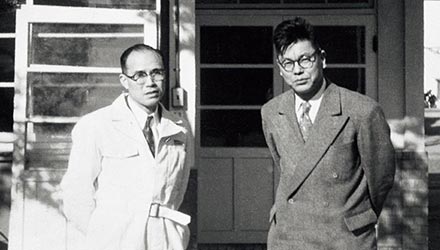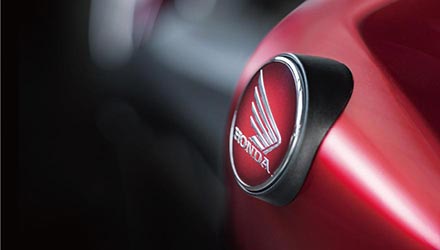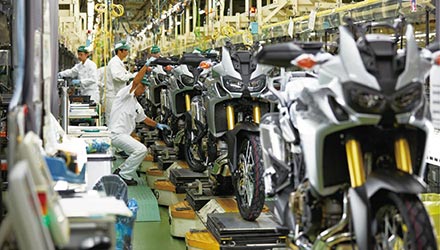Evolution Behind 50% Win Rate
 RC181
RC181
 NR500
NR500
 NS500
NS500
 NSR500
NSR500
 RC213V
RC213V
2023 marked the 65th anniversary since Honda first participated in the Road Racing World Championship (now MotoGP World Championship). In this period, Honda has won a total of 21 riders’ championships in the premier class (WGP500 / MotoGP (2002-2022 season)), and its activities can be divided into four eras.
1 1966 - 1967: 4-stroke
4-cylinder inline RC181
2 1979 - 1982: 4-stroke V4 NR500
3 1982 - 2001: 2-stroke V3 NS500, 2-stroke V4 NSR500 (2- and 4-stroke models ran concurrently in 2002, the first year of MotoGP)
4 2002 - present (2022):
4-stroke V5 990 cc RC211V,
4-stroke V4 800 cc RC212V,
4-stroke V4 1000 cc RC213V
Out of these Honda racing bikes, the NS500 and NSR500 won the riders’ championship 11 times in the 2-stroke era, and the RC211V, RC212V and RC213V won the championship ten times in the 4-stroke era. In other words, by the end of the 2022 season, Honda riders had won around half the championships in both 2- and 4-stroke eras, an unparalleled feat. From a different perspective, however, they failed to win in half the seasons they competed, and oddly enough, in both eras, there was a major breakthrough after four consecutive years of defeat.
Comparing the same 4-stroke engines, engine speeds exceeded 20,000 rpm for 125 cc and 50 cc engines in the mid-1960s, and the NR500, which used a 4-stroke V-4 engine with elliptic pistons, achieved 20,000 rpm. The RC213V has a displacement of 1,000 cc, twice that of the NR500, which increases friction, but can still rev to around 18,000 rpm. High rpm and high output have always been the basis of racing engines.
It is amazing that racing bikes of the past were able to achieve ultra-high RPM at a time when materials and processing technology were not as advanced, and analysis technology was rudimentary compared to today, but in other words, ultra-high revving engines existed 60 years ago. As requirements for engines have changed with each era, the technological direction of development have also changed accordingly.
 The NSR500’s high-output 2-stroke engine made it easier to pursue high revs.
The NSR500’s high-output 2-stroke engine made it easier to pursue high revs.
In the era of the 4-stroke 4-cylinder inline engines, the aim was to achieve high rpm and output, focusing on mechanical solutions. These experiences were applied in the NR500 era, and although the 4-stroke V4 engine was designed completely differently, it still aimed for ultra-high revs through mechanical solutions. In the NS500 and NSR500 era, the 2-stroke engines made it easier to achieve high output, so the engineers worked on output control to efficiently increase speed. And in 2023, with the 4-stroke V4 RC213V, the pursuit of higher rpm and output still continues, but technical issues focus on quality and durability that guarantee the performance.
In MotoGP in particular, regulations have become stricter over the past 20 years, with two engine displacement changes, fuel tank capacity restrictions, and a limit on the number of engines that can be used during a season, requiring a much higher level of engine performance and durability than before. In other words, in the past, absolute performance was demanded, then performance characteristics were demanded, and today, quality is demanded. In this sense, Honda’s technological efforts in MotoGP embody what can be considered the history of 4-stroke engine development in the 21st century.
RC211V

2002 RC211V, winner of the season-opener goes on to dominate by winning 14 of the 16 rounds.
 4-stroke V5 75.5° V-bank RC211V engine
4-stroke V5 75.5° V-bank RC211V engine
 Valentino Rossi, 2002 world champion
Valentino Rossi, 2002 world champion
The RC211V, introduced in 2002, the first year of MotoGP, used a completely new 4-stroke V5 engine design and won the riders’ championship in 2002 and 2003. This engine had a V-bank angle of 75.5° and a crank phase angle of 104.5°, which theoretically eliminated primary vibration. The bike’s performance, including the chassis, which the first development manager (Large Project Leader:LPL) said “would never lose,” led to victory in the opening round in 2002, followed by nine consecutive victories. In the end, it won 14 out of 16 rounds, dominating its rivals.
Behind the scenes, however, the development team was pressed to take measures against an engine that had been breaking down since just before the season-opener, with dubious durability. The engine used in the pre-season test broke down on the bench while checking performance. The pistons and valves were damaged due to galling on the smaller end of the connecting rods. As a result, the pistons, which were estimated to last 2,000 km, had to be replaced every 300 km until the measures could be developed. Two engines were needed per race, instead one per race as originally planned, as overhauls may not be completed in time depending on the race schedule.
A crash during the free practice session in the opening round had already thrown engine plans into turmoil. Fuel consumption was not up to the expected level, so engine output was reduced as a precaution. Despite this feeling of running on ice in the opening round, Honda has able to win the race convincingly, but the trouble persisted, and in the second round, the engine had to be disassembled at the racetrack. Shinya Wakabayashi, then project leader (PL) of engine development and former managing director and general manager of motorcycle racing at Honda Racing Corporation (HRC), recalled:
“Following the season-opener, we expected pistons to last 300 km, but when a staff member said we did not have enough engines and asked me if we could schedule two per race, I stopped him. We thought that the only way to make the situation better was to put bushings in the small ends to prevent galling, so we returned all the engines to Japan and asked the manufacturer to the conrod machining with the bushings still attached. We somehow managed to rebuild the engines. At that time, we were constantly repeating such measures, and there were many other issues such as broken valve springs on the intake side, missing stem ends, galling on the lifters, and problems with the valves and valve seats, and in the early part of the season we were constantly busy improving the accuracy of the valve train and changing the specifications.”
Improved parts were ready by mid-season, but in Round 10, the team retired for the first time in the season, putting an end to its winning streak. The direct cause was a blown rear tire, but before the race, a ram-air intake was introduced to increase output by about 5% (about 10 PS), and as a result, the tires did not hold up. The RC211V’s inability to withstand its own power output was a problem that continued to be addressed until the end of the season, with specifications changed and improvements made in a total of 87 areas.
“We were lucky that the only engine problems we had during the races were a broken clutch. In any case, many parts of the bike broke in 2002, and we had to devote ourselves to fixing them. Because of this, we were not able to fundamentally improve the engine’s performance until 2003.” (Wakabayashi)
 Structure of HITCS introduced in 2004
Structure of HITCS introduced in 2004
In 2003, Ducati, a new entrant to MotoGP, had superior top speed, so the RC211V’s rev limit, which was 14,750 rpm in 2002, was raised to 15,500 rpm to achieve higher rpm and power output (the final limit was 15,750 rpm). The RC211V, with a total of seven bikes from four teams, finished on the podium in every race it entered, and dominated the series with 15 wins from 16 grands prix. However, Valentino Rossi, who had won the riders’ championship for two consecutive years, moved to Yamaha.
For 2004, the engine’s bore and stroke were changed, and the rev limit was increased to over 16,000 rpm with a drastic change in the ignition interval as well as a higher rpm. The maximum output was increased from 226 PS (at the beginning of 2002) to 256 PS, and HITCS (Honda Intelligent Throttle Control System)*1 was introduced to optimize the driving force, in preparation for the season.
That year, Rossi won nine races, while Honda managed only seven, losing the championship to the former Honda rider by 47 championship points. In the series, Honda had riders in 2nd through 6th places, and won the manufacturers’ title for the fourth year in a row.
“That year, we updated the bike once every two races or so, and introduced about 10 different engine specifications. We tried asymmetric ignition timing and big-bang (simultaneous) timing, and I think we turned up the revs to 16,750 at the end. At the time, I was always thinking about what new thing we could try after every two races. I would spend half of every day in front of a bench talking with the power research PL and deciding basically what to change, I would go back to my seat at night and make corrections to the drawings, and in the morning the tracer would have them drafted so I could write different instructions the next night. My superiors told me, ‘We won’t complain about what you decide, so think carefully as a PL and make your own decisions,’ so I was constantly thinking about what I should do to make the bike faster and to increase the engine horsepower.” (Wakabayashi)
For the 2005 RC211V, major changes were made to the chassis, including modifications to the rear suspension and frame. Based on the riders’ feedback that the RC211V was less stable than Rossi during deceleration and turning, and slower on acceleration, improvements were made to the series of movements from turn entry to exit. However, the results were disastrous: Rossi finished on the podium in all but the one race in which he retired, with a total of 11 wins in 17 races. In contrast, Honda riders won only four races.
Honda had three different versions of engines and chassis throughout the 2005 season, but they could not compete with Rossi. In fact, there was a secret plan to beat Rossi by introducing a completely different design mid-season. The new bike was based on a new engine that was being developed for the 2007 800 cc season, but simultaneous development of three models, the 2005 RC211V, the next bike based on the 2005 machine, and the completely different new model, was extremely difficult, and it took until the following year, 2006, for the new machine to be introduced in actual racing.
This new racing bike was called the “RC211V New Generation,” powered by a V5 engine based on the V4 engine which had been thoroughly downsized to 800 cc. Its size was completely different from the V5 engine that had been used until then. However, the engine was so radically downsized that the durability of its components was questionable, and the engine was so fragile that it broke down after about 30 engine tests without even lasting one lap. This was the reason why the engine could not be introduced in time for 2005.

Compact RC211V New Generation engine (right)

RC211V with New Generation engine
 Nicky Hayden, 2006 world champion
Nicky Hayden, 2006 world champion
The RC211V New Generation was able to be introduced after thorough scrutiny and improvement of all materials, designs, and machining accuracy, as well as parts management with unprecedented detail and timing, and also by replacing the entire engine each race. Even so, only one engine was available, which was given to Nicky Hayden, while the other riders rode the normally evolved RC211Vs. The RC211V New Generation was a completely new design with a completely new chassis and bodywork to match the smaller engine, and was well-balanced with greatly improved stability during deceleration, turning, and stand-still acceleration, which were the same development themes as the 2005 RC211V.
The 2006 season was a three-way battle between Honda, Yamaha, and Ducati. Honda’s Nicky Hayden was consistent throughout the season, leading the standings. However, in a dramatic penultimate round, Hayden crashed, and although Rossi took the lead in the points, he also crashed in the season finale, giving back the riders’ title to Hayden. In the end, Honda riders won eight races, including two by Hayden, Yamaha (Rossi) won five, and Ducati riders won four, for a closely contested season.
- An electronically controlled throttle that detects the difference in speed between the front and rear wheels and automatically adjusts the throttle angle to suppress wheel spin and wheelies. In addition to efficient acceleration when exiting turns, the throttle automatically opens during deceleration to allow the engine to run smoothly and prevent hopping caused by engine braking.

RC211V New Generation, which only Nicky Hayden rode







